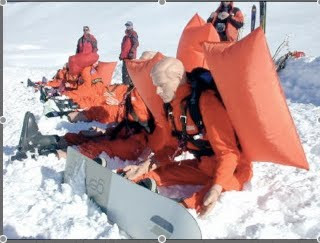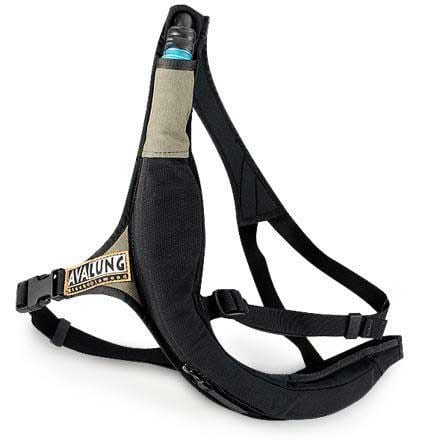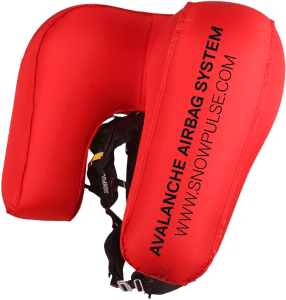The big fear many skiers have is being hit by an avalanche. If you are, your odds of surviving depend almost entirely on how quickly people can dig you out. Fortunately there are a number of new gadgets including the Avalung and Avalanche Airbag that speed up search and rescue, keep you alive longer and even reduce your odds of being buried in the first place.
After I came across this amazing video showing helmet-cam footage of a guy being buried in snow and then surviving the avalanche thanks largely to the help of his rescue gear I got to wondering just how effective the Black Diamond Avalung is and how it compares with other products out there such as the European Avalanche Airbag System and the usual avalanche transceivers (locator beacons) as well as traditional avalanche rescue gear such as snow probes.

It turns out that this has been some pretty serious scientific and medical testing that has gone into the newer devices and there are also some well-documented saves on both. Avalanche safety and rescue really has come a long way.
First a primer on what kills you in an avalanche:
When an avalanche hits, it is not the impact or the tumble that is most likely to kill you. Statistics gathered by the Swiss show that if you get buried in snow you only have about a one-third chance of surviving. In comparison, more than 9 out of 10 avalanche victims who end up on the surface survive.
What gets you is being buried alive. If you are, your chances of surviving go down dramatically after about 20 minutes and by 40 minutes you would have to be in the lucky few percent to survive (see chart from this study).
 These sobering numbers have led to three different approaches to trying to save lives. The first is focused firstly on trying to find victims quickly when they are buried. Modern transceivers and detectors can be a big help here. Some are even built into jackets, so that there is less chance of forgetting them at home.
These sobering numbers have led to three different approaches to trying to save lives. The first is focused firstly on trying to find victims quickly when they are buried. Modern transceivers and detectors can be a big help here. Some are even built into jackets, so that there is less chance of forgetting them at home.
The second approach is on trying to keep victims alive longer under the snow using Black Diamond’s Avalung. The longer they can keep breathing, the more time there is to find them. Obviously a transceiver would still be a big help here.
The third approach, which is more popular in Europe than in the US, is to try to prevent avalanche burial in the first place by using an airbag, which is a bit like a life jacket, to help “float” victims to the top of the tumble.
How does the AvaLung work?
The theory behind the AvaLung is that even fairly densely-packed avalanche snow is still about 50% air. There are, however, a couple of problems with trying to breathe it:
- You end up mixing your stale air with your fresh and run out of oxygen because you are breathing the same air over and over again
- The steam in your breath ices over when it hits the cold and seals you in, closing the tiny gaps in the snow that could be giving you life saving air.
- When you get tumbled you end up with snow packed in your mouth and nose. Even if there is air, you can’t get to it.
Avalung (pictured here) tries to get around these problems by getting you to suck air in from one side of your body and then breath it out through the other, so it keeps your fresh and stale air apart and any icing up happens away from where you are sucking in. If you are biting down hard on it before you get hit, you also keep your mouth clear of snow.
Does Avalung work in the lab?
The main study on the Avalung, which was published in the Journal of the American Medical Association in 2000:
For the study, 8 unfortunate saps agreed to be buried in snow and then have their vital signs monitored. It found that people managed almost an hour under the snow with a device compared with 10 minutes without one. Further trials have taken to 33 the number of people who were intentionally buried to test it and, at least under controlled conditions, it does what it is supposed to do.
Does Avalung work in the field?
There have been a number of well documented saves with the Avalung including this official report of three people who survived burial and this pdf report of a guy who survived being buried for 2-40 minutes while two others in his group did not make it out. Another survival story, this one from France, is that of Martin Gulsrud of Norway who spent about 20 minutes under the snow and reckons he would not have survived without his Avalung.
“The only thing I focused on was having space around my lungs, and I remember thinking how this would be without the Avalung. I am very glad I didn’t panic and struggle against the forces of the avalanche. I was very frightened until I concluded that the snow wasn’t moving any more, I realized I could breath and that I was in a position where I cold stay alive for awhile.”
To be fair, there are also a fair number of reports of people being found dead with AvaLungs that they didn’t use properly. The numbers, however, are far too low at this stage to draw firm conclusions. Nor can more realistic tests be done (such as dropping people in front of real avalanches). Yet this uncertainty is far outweighed by the light weight and relatively low cost of the AvaLung and the fact that it is built into a wide range of packs. If you can spring the cost of a ski trip, you can afford the insurance that an Avalung offers
 What about the Avalanche Airbag System (ABS)?
What about the Avalanche Airbag System (ABS)?
This is a way more expensive piece of kit (6-10 times more), and is heavier too. It works almost entirely on the principle that it is better not to be buried than to hope someone will dig you out.
Lab tests of the early version (1995) of ABS where dummies with and without airbags were put into an avalanche showed that it would have improved survival chances. The dummies were closer to the surface and less completely buried and in almost all cases (expect where the bags didn’t inflate) the airbags were visible on the surface.
Is ABS proven in the field?
The most important data comes from an statistical analysis of Swiss avalanche incidents that showed a significant survival rate for people wearing an ABS system. The study conducted by the Swiss Institute for Snow and Avalanche Research found that:
In the time between February 1991 and February 2000 there have been 26 avalanche in-
cidents worldwide which are known and documented, and in which 40 people wearing an ABS system were involved. 32 of them successfully released the balloons. 6 people failed to tear the release mechanism, and in the other two cases the balloons probably were not inflated due to technical malfunction of the system.
16 of the 32 people with the balloons were not buried, 11 were partly buried and 5 were completely buried. In 4 of the 5 cases of total burial the balloon stayed visible on the avalanche surface, which allowed fast location and recovery companions not buried. These 4 people survived the total burial.
…
To conclude, one can state that 31 people with inflated balloons who were caught by avalanches survived the incident, only one was killed.
Another option to consider is the Snowpulse, which works much like the ABS but in this case the bag comes right up around the head to offer protection against impact as well as hopefully providing an air pocket.
A comparisonof how all three approaches work conducted for the Austrian Association for Alpine and High Altitude Medicine found that:
- The ABS system more than halved one’s chances of being buried (to about 16%) and reduced the chances of dying in an avalanche to about 2.5% from about 23%.
- Transceivers cut the time to rescue to 35 minutes from 120 and cut mortality from 76% to 66%
- There was insufficient data to assess the AvaLung, but they noted its light weight and low price
My reading of the data is that there seems to be a good chance that between them a modern transceiver and AvaLung will improve your odds without breaking the bank. But if you’ve got the cash it looks like ABS is the way to go. And without wanting to preach – whatever your gear, please be careful out there. If you ever find yourself thinking that you might try something because of your rescue equipment that you wouldn’t have done without it, then you should probably turn around.
UPDATE
In January 2012 an amazing video was shot of a snowboarder caught in an avalanche and coming out on top using the Avalanche Airbag System.
Snake River Float Avalanche Airbag Save
This avalanche airbag footage was caught on January 25th, 2012 in the Snake River backcountry near Montezuma, Colo. It features pro snowboarder Meesh Hytner getting caught in an avalanche and staying on top after deploying her BCA Float 30 avalanche …
There is also some good footage here from the manufacturers conducting tests on dummy’s using the ABS. It is in German but even if you don’t speak the language you can still get a good sense of what they mean.
Airbag Dummies mostley get coucht in avalanches!



Tor says
Great article. I have decided to go for the ABS. Thanks for the breakdown.
Tor
Kil says
Really stuff here. Thank you for researching this and assembling the data